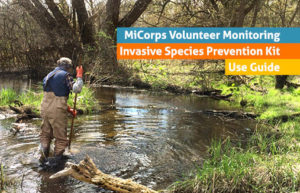Decontaminate Your Monitoring Gear!
Invasive Species in the Huron River Watershed and Beyond
Invasive species are plants and animals that originally come from another area of the world, and can easy become established in our ecosystems. Infamous aquatic invasive species include zebra mussels, starry stonewort, New Zealand mudsnails, the sea lamprey, round gobies, eurasion water milfoil, and the Asian carp. Some terrestrial species are honeysuckle, common buckthorn, garlic mustard, dame’s rocket, and autumn olive.
How do invasive species impact an ecosystem?
All invasive species share some similar properties- they grow fast and dense, they crowd out native species and lower their diversity and abundance, and very often they can damage human economy and health, as well.
Each individual species can also have its own effects. Zebra and quagga mussels, for example, are filter feeders and increase water transparency by filtering out algae and nutrients in the water. This reduces food for other life, but also the increased transparency can make the lake more hospitable for invasive plants, like eurasian water milfoil.
Eurasian water milfoil and other invasive aquatic plants like Starry Stonewort or European frog-bit can grow so dense and thick that they can twist in the motors of boats and stop people from boating and recreating. It is nearly impossible to eradicate such plants once they take hold in a system, and controlling them to manageable levels often requires chemicals which are distasteful to many and can have their own side effects on a lake system.
And of course, who hasn’t seen the terrible impact of Asian Carp? If you somehow missed it, check out YouTube! Asian Carp haven’t spread to the Great Lakes system yet in any harmful way yet, but they are hovering on the borders of the Great Lakes and dealing with them is a scientific and political quagmire!
What You Can Do

Learn More! These resources can help you identify and report invasive species and prevent them from spreading when you boat or paddle or when you volunteer for one of our stream monitoring programs.
For terrestrial systems, many land conservancy or park systems have need of volunteers to help remove invasives . . . . For example, Ann Arbor Natural Area’s Preservation program has volunteer opportunities.
In lakes, the best solution to stop invasive species is prevent them from entering in the first place. Programs like Clean Boats, Clean Water train volunteers and show boat owners how to clean boating equipment to stop the plants from entering! Programs like MiCorps‘ Exotic Aquatic Plant Watch help volunteers find the plants before they become too abundant to stop.
Similarly, in stream ecosystems stopping spread is the most important thing. As an angler, a boater, or a researcher on stream systems, considering making a decontamination kit and use it to kill invasive species before you go to different location.
More Information
- MISIN— Report and Map invasive species with Midwest Invasive Species Network
- Michigan EGLE— Michigan Department of Environment, Great Lakes, and Energy has oodles of information on invasive species.
- MiCorps— monitor your lake for invasive species
- Common lake invaders: Aquatics Early Detection Flyer
- Clean Boats, Clean Water Program
- Ann Arbor Natural Area’s Preservation
- HRWC Invasive Species Field Report, Starry Stonewart: A Serious Threat to Michigan Lakes



